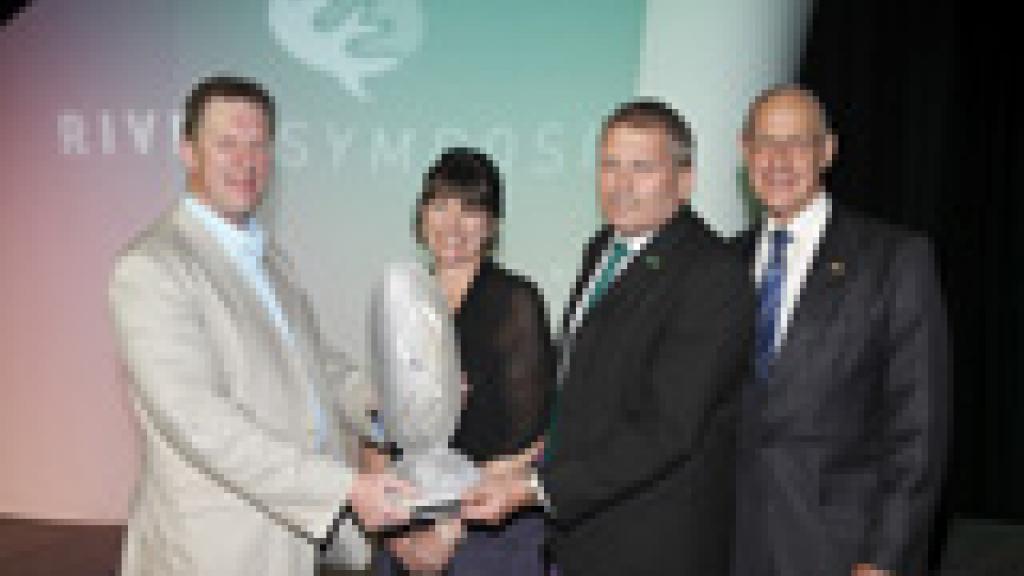River Thames Wins Theiss River Prize 2010
Perth, 12 October 2010. The River Thamse was selected as the winner of the world’s largest environmental prize in 2010. It was presented to the Environment Agency at the Riversymposium in Perth. The Danube had won the prestigous prize in 2007.

The Environment Agency has collected the world’s largest environmental prize after Britain’s most iconic river was crowned the beauty queen of the planet’s waterways.
The River Thames was selected out of hundreds of rivers across every continent as the winner of International Theiss River Prize, which celebrates outstanding achievement in river management and restoration.
London’s renowned waterway was up against the world-famous Yellow River, in China, Hattah Lakes, Australia, and the Smirnykh Rivers Partnership, in Japan in the competition’s finals.
The Thames scooped the prize thanks to its dramatic recovery from a biologically dead river in the 1950’s to today’s thriving waterway; teeming with fish, and with returning salmon, otter and sea trout populations.
The chemical quality of the rivers within the Thames catchment classed as ‘Very Good’ or ‘Good’, has improved from 53% in 1990 to 80% in 2008 while the estuary supports viable shellfisheries and is a nursery ground for commercial sole and bass stocks. The numbers of fish are increasing, with 125 different species recorded, including internationally important smelt and shad.
Since April 2005, 393 habitat enhancement projects have been completed and nearly 70 km of river has been restored or enhanced.
Alastair Driver, the Environment Agency's National Conservation Manager, said: “In the last 150 years the Thames has been to hell and back, and it has taken thousands of people many decades to restore it to this point. Tighter regulation of polluting industries and our work with farmers, businesses and water companies to reduce pollution and improve water quality, have all helped to make the Thames a living river once again.
“But the recovery is fragile, and under increasing pressure from a growing population, ageing infrastructure and climate change. Through innovative projects such as the Thames Tideway tunnels and the London Rivers Action Plan, we and all of the people and organisations we work with are proving that we are tackling these challenges head on to ensure that the Thames remains an iconic river for many centuries to come.”
The Environment Agency has pledged that the $350,000 AUD (Australian Dollars) prize money will go to the Thames Rivers Restoration Trust. Part of the prize fund will be used by the Trust to establish a twinning project to help restore a river in the developing world.
The award was presented October 12, at the International Riversymposium in Perth, Australia.
About the entry
The Environment Agency submission for the international river prize focused on five innovative projects put in place to further improve the quality of the Thames and its tributaries:
Working with farmers – which has helped to reduce pollution from nutrients and pesticides.
The Jubilee River Flood Alleviation Scheme - which has created a new 11 km stretch of naturalistic river and habitats, whilst delivering flood protection to 5,500 homes.
The London Rivers Action Plan - which is helping restore London’s urban rivers, with 58 new river restoration projects in progress since its launch in 2009.
The London Tideway Tunnels - a £3.6bn scheme tackling the 39 million tonnes of storm sewer overflows that enter the tidal Thames annually.
Thames Estuary 2100 - a 100-year adaptable plan to ensure the future sustainable management of tidal flood risk in the Thames estuary, and protecting over 1.25million people and £200bn in property value.
The London Tideway Improvements - three Thames Water schemes to tackle the 39 million tonnes of storm sewer overflows that enter the tidal Thames in an average year. These are the £675m Sewage Works Upgrades, the £635m Lee Tunnel, and the proposed Thames Tunnel (estimated cost £3.6bn).





